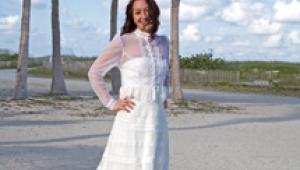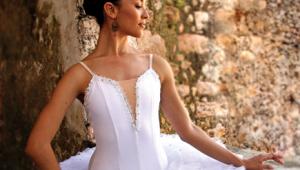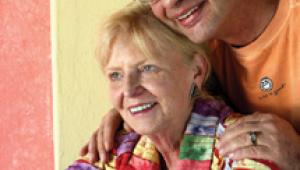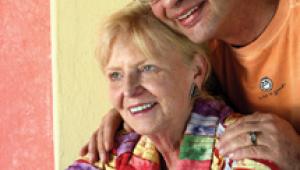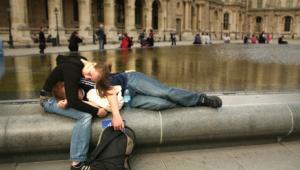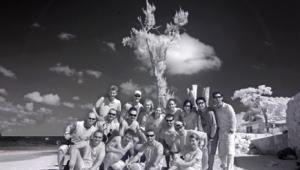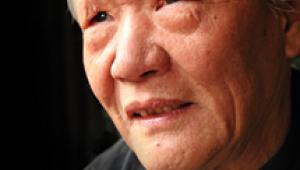Master Class
Simplify And Clarify; Taking The Mystery Out Of Lighting
Isn't it time that we simplify and clarify what portrait lighting is
about? I think so! Many photographers are afraid to photograph indoors, because
they don't know what to do with light. Others go outdoors and take snapshots,
because they don't know how to control light.
I was fortunate enough to learn one simple lighting pattern that works for everything
I do--whether it's portraits or landscapes. Whatever my source of
light might be, I'm always going for light that creates a three-dimensional
appearance on my subject matter. For portraits it's a light that comes
from slightly above the subject's eyes and just a little to one side.
I'm looking for light in the subject's eyes and a shadow on the
side of the nose that comes just to the base of the nose.
Here's a typical setup for my classic portraiture that works every time for every subject. My main light creates the lighting pattern. With digital photography I'm exposing for the main light, so that I don't overexpose the highlights. A fill light behind the camera is 2 f/stops less than the main light. When I'm working with a full set of lights (as I'm doing here with my Photogenic lighting setup) I also use a hairlight, being careful that it doesn't spill over onto the face. Another light is opening up detail in the background. I can lighten or darken the background by putting more or less light on the background than on the face.
 |
|
|
I'm using the same setup on location with the bride and groom. You can see the main light to my left, crossing over the bride's body for more detail and going toward the groom. (The couple, by the way, is Toby and Charlie, two of my favorite models. They have their own portrait business on the West Coast of Florida.) All of this month's photographs are of them, so that I can illustrate how many different ways I can light them--always going for the same lighting pattern. Sometimes it's more obvious than others, but I always have that pattern in mind when I begin.

Lighting them inside the church was a combination of available light and a
Quantum digital flash used bare bulb (without the reflector attached). I posed
the couple as far from the background as I could in order to make them the center
of interest and keep the background of the church secondary. I used a wide angle
lens and stayed within 5 or 6 ft from them with my Canon EOS 20D and a 17-35mm
lens.
The exposure was set by letting the camera do its thing. I set the camera on
Aperture Priority, allowing the automated sensor to select the shutter speed
for the background. I then set the camera manually to the exposure that the
camera had selected and let the digital sensor of the flash do the rest. Quantum
has a sensor that can be mounted on top of the camera that can set the balance
of flash-to-ambient light anywhere from 3 f/stops below the ambient light to
3 f/stops above the ambient light. I've found that for a very natural
look I like to have the flash 11/2 stops below. If you look carefully you can
see the shadow from my flash on the floor behind Charlie.
To have the color of the flash match the color of the ambient light I create
a blank layer on top of the picture by setting the mode to "overlay."
Then, I select a color from the background and fill the top layer with that
color. Finally, I bring the opacity of the overlay down to around 8 or 10 percent,
or to where it looks most natural.
The flash is off to my left side by means of an extension cord between the flash
and the camera. I placed the flash to where I would achieve the same exact lighting
pattern as I always use on my subjects.

When photographing outside I first look for two basic things:
1) a cover from overhead light and 2) a background with depth. Under cover of
the church's front walkway was an ideal location. I placed Toby and Charlie
where there was ambient light coming in from their left side and slightly behind
them. The exposure was selected for the ambient light on them before I used
a flash. In order to achieve the same lighting pattern on their faces I placed
my Quantum bare-bulb flash to my right, again achieving the same lighting pattern
on them as before. At 11/2 f/stops below the ambient light it's very subtle
and does not change the natural look of the ambient light.
The white balance for all the pictures in this series was set by pointing the
camera's lens toward the light source with an ExpoDisc covering the lens.
Then, I told the camera to set the white balance according to the exposure that
I made with the disc covering my lens. It takes only a few seconds to achieve
a near-perfect white balance. Worth the effort? I would say so!

Window light (at no surprise to you by now) also cries out for
the same lighting pattern. It's best achieved a few feet from the window,
rather than right next to it. At a similar distance of light-to-subject as in
a studio environment the light wraps around the subject more softly and there
is much less contrast than when the subject is closer to the window. In the
insert of this photograph you can see how I've used a Westcott silver
reflector (Monte's Illuminator) below and to the side of her face to open
up the shadows and her eyes from below.
The way I've posed the two of them together by window light is creating
a slightly different lighting situation from the previous window light picture.
Still, the lighting pattern is very similar. I've posed them so that they
both are getting light on the left side of their faces. In order to achieve
that I've had to position Charlie slightly ahead of Toby, allowing the
light onto his left cheek.
Now, with no light in their eyes and only lighting one side of their faces with
the window light, I've placed my silver reflector camera-right. I've
turned it toward the window to pick up the light and then angled it much like
a mirror from my right side to reflect the same light pattern onto the shadowed
side of their faces.
 |
 |
Does the same lighting pattern work outside in bright sunshine? Of course it
does!
- Log in or register to post comments



